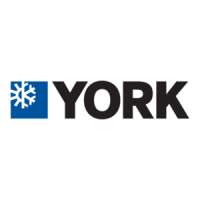JOHNSON CONTROLS
34
Form 150.63-NM9
Issue date: 5/20/2021
SECTION 4 – INSTALLATION
Discharge Air Sensor
The discharge air sensor and associated connector
hardware are field supplied and installed. Field wire
must be field supplied (QUABBIN 930421-2 or equiv-
alent 2 conductor with shield and drain wire - 20 AWG
300 V 60°C - polyethylene insulation UV resistant).
Field wiring is connected to pins 2, 5, and 8 of J6 on
the microboard. See Figure 4 on page 22, and the unit
wiring diagrams starting on page 52.
Zone Thermostats, Suction Pressure Control
Only (Remote Start/Stop)
Field supplied thermostats or dry contacts must be
field wired to start/stop the respective system when
operating the unit in Suction Pressure Control
Mode. The System 1 zone thermostat is field wired at
CTB1 terminals 13 to 50. On two system units, System
2 zone thermostat is field wired to CTB1 terminals 13
to 51. CTB1 terminal is located near the bottom of the
micro control panel. See Figure 4 on page 22, and
the unit wiring diagrams starting on page 52.
Air Proving Switch/Remote Start-Stop Contacts
The air ow switch must not be used to
start and stop the chiller (for example,
starting and stopping the blower). It is
intended only as a safety switch, so it can-
not be jumped out.
The air proving switch is field wired to CTB1 termi-
nals 13 to 14 to prevent operation of the refrigerant cir-
cuit when the supply air blower is not operating.
If separate evaporator blowers are used with respect
to each refrigerant system in the condensing unit, then
two air proving switches (used for each blower) must
be wired in series across CTB1 terminals 13 to 14. See
Figure 11 on page 39 and the unit wiring diagrams
starting on page 52.
Evaporator Blower Start Contacts
For constant fan operation: Terminal block TB1 - ter-
minals 23 to 24, are normally open contacts that can be
used to switch field supplied power to provide a start
signal to the evaporator blower contactor. Contacts will
close whenever the daily schedule is programmed for
cooling. See Figure 11 on page 39 and the unit wiring
diagrams starting on page 52.
Relief Valves
Relief valves are located on both the high and low
pressure side of the piping. The high side relief valve
pressure setting is 650 psig. The low side relief valve
pressure setting is 450 psig.
High Pressure Cutout
A high pressure cutout is installed in the discharge pip-
ing of each system. The cutout opens at 585 psig plus
or minus 10 psig and closes at 440 psig plus or minus
25 psig.
Compressor Heaters
Compressor heaters are standard on all models. If pow-
er is OFF more than two hours, the crankcase heaters
must be energized for 18 to 24 hours before restarting
a compressor. This will ensure that liquid slugging and
oil dilution does not damage the compressors on start.
Refrigerant Piping
General
When the unit has been located in its final position, the
unit piping may be connected. Normal installation pre-
cautions should be observed in order to receive maxi-
mum operating efficiencies. System piping should con-
form to the YORK DX piping guide Form 50.40-ES2
or ASHRAE refrigeration handbook guidelines. All
piping design and installation is the responsibility of
the user.
JOHNSON CONTROLS ASSUMES NO WAR-
RANTY RESPONSIBILITY FOR SYSTEM OP-
ERATION OR FAILURES DUE TO IMPROBe-
forePIPING, PIPING DESIGN, CONTROL
PROBLEMS, OR LACK OF OIL RETURN.
Filter driers and sight glasses are shipped loose for field
installation on each refrigerant circuit. Field refrigerant
piping can be connected to the condensing unit.
All expansion valves, liquid line solenoid valves, and
refrigerant piping are field supplied and installed. TXV
sizing should be equal in size or slightly smaller than
the capacity of the circuit. If multiple coil sections are
utilized, a TXV for each section (sized accordingly)
must be installed.

